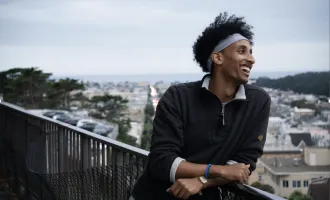
This Date in UCSF History: Six Days in San Quentin
Originally authored by medical student Eric Chow and published in Synapse on November 20, 1998.
After a five-minute walk, I finally reached San Quentin’s main entrance and was now set to enter the prison proper. I had already crossed two other security checkpoints, taking me past auxiliary buildings and a chain-link fence topped with barbed wire.
The main entrance resembled a Victorian-era castle, with its fanciful turrets, crenellations, and wrought iron gates. The massive walls that spread out from the gate were more ominous, their facades pierced by rows of tiny slits.
Inmates sat within. I displayed my UCSF identification and my driver’s license, signed in, and had my bags checked for the third time. This time, however, the inspection was more thorough and the butter knife I always pack with my lunch was confiscated.
“These can be sharpened into a weapon,” the guard informed me. “Don’t ever bring anything like that knife on the way out.”
Embarrassed, I was also glad he didn’t notice the pointed end on my reflex hammer used to test pain sensation. As I followed my guard escort, three iron gates unlocked in succession with harsh metallic clangs, and I was in.
I spent six Fridays in San Quentin’s infirmary as part of my Family and Community Medicine rotation. The contrast between San Quentin’s stark facilities and the plush modernity of UCSF’s Ambulatory Care Center — where I spent the rest of my week — could not be greater.
From a medical-education point of view, I may not have learned that much in prison, but interacting with inmates and seeing the innards of this institution was an unforgettable experience.
San Quentin, site of California’s death row, sits incongruously on a very pleasant and posh peninsula north of Marin, next to the Richmond Bridge.
Like Alcatraz, the wonderful views can only make captivity that much harder lo bear. The oldest sections of the facility date from the late 19th century, but the prison blocks where prisoners are housed were built earlier this century.
The prison is no longer maximum security (except for death row), and nowadays primarily serves as Northern California’s main prisoner transfer facility. Most inmates are housed temporarily at San Quentin (often several months), medically cleared, and then shipped to a more permanent facility elsewhere in the state.
Aside from the condemned, a small number of inmates make up the “mainline” population that stay in San Quentin for the duration of their sentence. At any one time, the prison holds roughly 5,000 to 6,000 people.
In the mornings, I always pass by the newly arrived prisoners on my way to the infirmary. Wearing bright-orange jumpsuits, they line up outside the mess hall where they pick up lunches in brown paper bags.
On the ground are lines proclaiming “out of bounds” dictating where prisoners cannot be. My escort and I walk along a narrow path defined by those lines, until we enter the infirmary where the lines disappear, and everyone is mixed together.
I was very intimidated my first day, not just because I was suddenly surrounded by orange-clad inmates, but also by the heavy sense of authority that permeates the place: the lines on the ground, the bars and thick walls, the presence of burly guards everywhere with batons, mace, and bullet-proof vests.
Helping Dr. T.
At the infirmary, new inmates get screening physicals and those with medical conditions arc further evaluated. On Fridays, I helped Dr. T. evaluate those patients.
Dr. T. was born in Vietnam and worked as a pediatrician for many years on the East Coast. After retiring and moving to California, she decided to come out of retirement last year and found prison medicine to be relatively well-paying, albeit tiring.
She had the perpetual frown and stooped posture of a woman who’s been up seeing patients since 7:30 and doesn’t expect to have a break until 2 p.m. at the earliest.
Aided by two RNs and several uniformed LVNs, she saw up to 15 inmates per hour, putting people back on their blood pressure pills, asthma inhalers, seizure meds, etc., as well as dealing with colds and other acute illnesses.
In addition to evaluating the new arrivals, Dr. T. and the nurses maintain a drop-in clinic for the other inmates. ln order to be seen at drop-in, inmates file a request, and their names are then placed on a list.
In an attempt to reduce the number of superfluous requests, inmates pay a $5 co-pay for each visit. Nevertheless, given the shorthanded medical staff, requests often go unfilled for days.
Truly acute problems and trauma from fights are dealt with emergently, and the more severely ill or wounded are transferred to a prison hospital in Novato.
In addition to Dr. T, about half a dozen other doctors work full-time at San Quentin, helped by several moonlighting private practitioners. A couple of the physicians specialize in HIV/AIDS, and there are a number of full-time psychiatrists on staff as well.
Mainline inmates serve as X-ray and lab technicians, many having worked at those positions for years. Dr. T. readily acknowledged that the care was often limited, given the limited formulary, the extremely old facilities and equipment, and shorthanded staff.
Aside from aspirin and Tylenol, symptomatic relief is often not offered. While the infirmary provides X-ray, newer imaging techniques are unavailable; inmates requiring more specialized treatments must be transferred to an outside prison hospital.
Also in limited supply are the warmth and caring found in an ideal patient-doctor relationship. While inmates were generally courteous, even obsequious at times, the medical staff was often brusque.
It is easy to automatically consider criminals untrustworthy, and suspicion for malingering and secondary gain is high. Complaints of chronic pain were common — and often linked to requests for painkillers, a lower bunk, or lower floor housing (no elevators in the prison blocks).
After several days, I found myself becoming inured to that environment and becoming dismissive of young men with chronic lower back pain. The time pressure and constant line of patients does not help improve the atmosphere.
Nevertheless, congeniality in prison is not entirely absent. I often saw shackled inmates chatting and joking with their guard escorts. Many inmates were genuinely grateful at being treated, and the medical staff genuinely gracious in return.
The inmates I saw were generally younger men, mainly Latino and African American, with fewer Caucasians and very few Asians. Inmates were rarely over 50 years old, and I did not see anyone over 70.
Many passing through were parole violators, back in prison for a short, several-month stint. Many violations involved drug possession. One man had violated parole because he moved out of the county after he and his wife found an incredible deal on a house in an adjacent one.
As for the original crime, it seemed an unwritten rule that no one on staff ask inmates to specify why they had been admitted. Nevertheless, drugs and gang violence were common, often intertwined themes.
People on death row were distinguished by their yellow jumpsuits and by always being shackled and accompanied by two guards when visiting the infirmary. During my six days at San Quentin, I got an inside glimpse of death row only once.
A Glimpse of Death Row
Death Row is a prison within a prison occupying the easternmost prison block at San Quentin. The roughly 450 prisoners there were generally isolated from the rest of the prison with their own recreation yards and meals.
In an attempt to decrease violence, rival groups (e.g., people from Northern versus Southern Mexico) were prevented from mixing by having separate recreation yards.
The guard presence within East Block was also much higher, and prisoners were stripped and searched whenever they left or re-entered their cells. However, condemned prisoners had certain privileges — more frequent visitation rights — and their own private cells.
Inmates elsewhere had to share a six-by-eight-foot space with another person.
An odd relationship develops between the guards and the prisoners, as they both become very familiar with one another, seeing each other every day. Their rapport reminded me of longtime neighbors greeting each other and making small talk all the time across the fence, but not knowing the other person more than superficially.
Prison guards were a heterogenous group. There were experienced veterans and fresh recruits straight from school. Some guards were built like NFL linebackers, some were slender. Ethnically, guards were more diverse than the prisoners. I saw only a few female guards.
Their days are filled with long hours of observation punctuated by periodic minutes of alarm. Alarms sounded in response to fights or medical emergencies (the first sometimes leading to the latter).
During my time at San Quentin, lockdowns — when all inmates returned to their cells and the day’s activities were suspended — occasionally occurred.
One was in response to half a scissor being missing. Despite a search of all the cells and public areas, it was never found.
One consequence of the search was that over the next few days, many inmates reported to sick call complaining that their daily medications had been thrown out in the process.
Another time, an inmate was absent from roll call, and a lockdown ensued. He was eventually found on the prison grounds, trying to hide.
Although I did not learn that much medicine at San Quentin, I never got bored. Absorbing the atmosphere and talking to guards, prisoners, and medical staff, each with their own perspectives, made the experience a rich and interesting one.
Considering the number of people being sent to prison these days, I think it is important to see what prison is like. The crowded living situation, the threat of physical harm, the monotony of daily life, and the short supply of compassion combine to make prison extremely unpleasant, especially if one is ill.
It was discouraging to see so many young men in prison, many of whom have been incarcerated multiple times. It makes you wonder about the quality of their lives out in “free society” that makes the threat of imprisonment seem undaunting.
Clearly, more effort needs to be put not into legalistic deterrence, but into addressing the underlying causes of most crimes: poverty and poor social support.
The experience challenged my perceptions of “criminals” and my attitude toward potentially “difficult” patients.
For example, I befriended an inmate who operated the X-ray machine. Despite my initial suspicion, his constant good cheer and openness ultimately won me over.
I also learned how easy it was to be dismissive of patients who are uncooperative or appear to be exaggerating or falsifying their condition.
Learning to deal with such patients equitably will be an important skill whether I am in prison or at the Ambulatory Care Center.



